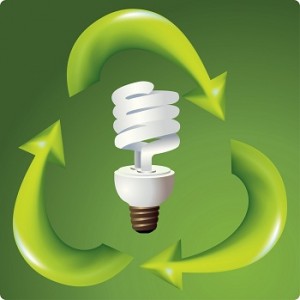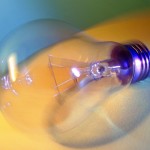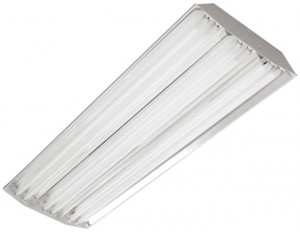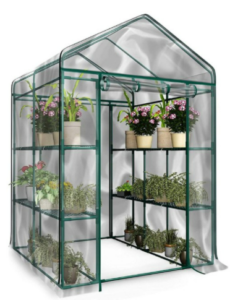Energy Efficiency Lighting
 Lighting accounts for 20% to 25% of all American energy consumption. An average household dedicates 5% to 10% of its energy budget for lighting, or commercial establishments consume 20% to 30% of their total energy use for lighting.
Lighting accounts for 20% to 25% of all American energy consumption. An average household dedicates 5% to 10% of its energy budget for lighting, or commercial establishments consume 20% to 30% of their total energy use for lighting.
Electricity is usually converted into light (in residential buildings) in incandescent or fluorescent lamps.
Illumination
A lumen measures light output from a lamp. All lamps are rated in lumens. For example, 100-Watt incandescent lamp produces about 1750 lumens. Dividing a lamp’s number of lumens by its watts gives efficacy-a measurement of lighting efficiency.
The distribution of light on a horizontal surface is called its illumination. Illumination is measured in footcandles. A footcandle of illumination is a lumen of light distributed over one square foot of area.
The amount of light required, measured in footcandles, varies according to the difficulty of a visual task. Ideal illumination is the minimum footcandles necessary to comfortably perform a task at the maximum practical rate of speed without eyestrain.
In the past, illumination of 100 footcandles was thought to be minimum for visual tasks in the workplace. Now, the Illuminating Engineering Society says that 30 to 50 footcandles is adequate for most home and office work. Difficult and lengthy visual task, like sewing for extended periods of time, requires 200 to 500 Footcandles. When no seeing task are performed, the lighting system needs to provide only security, safety, of visual pleasure – from 5 to 20 footcandles.
Lighting uses
Three categories of lighting by faction are ambient lighting, task lighting and accent lighting.
Ambient lighting provide security and safety, as well as lighting the tasks that occur throughout the lighted space.
Task lighting provides light at the work area. Illumination levels should be high enough for accurate task execution in task areas – not throughout the entire lighted space.
Accent lighting illuminates walls so that their brightness contrasts less with brighter areas, like ceilings and windows. Accent lighting is also used to make the space more visually comfortable.
Lighting Color
Lamps are assigned a color temperature depending on their “Coolness” or “warmness.” people perceive color of the blue-green end of the color spectrum is cool and those of the spectrum’s red end as warm. Morning light from the North is a more bluish then Southwest evening light.
Cool light sources are preferred for visual task, since they produce better contrast at the printed page, workbench, or other tasks. Warm light sources are preferred for living space, because they are more flattering to people’s skin and clothing.
Incandescent Lamps
 Incandescent lamps are the oldest, most common, and most inexpensive lamps. Incandescent lights is produced by a white-hot coil of tungsten wire that glows when heated by electrical current. The type of glass enclosures surrounding this tungsten filament determines its light beam’s characteristics. Only 10% of the electricity is converted into light, the other 90% becoming heat.
Incandescent lamps are the oldest, most common, and most inexpensive lamps. Incandescent lights is produced by a white-hot coil of tungsten wire that glows when heated by electrical current. The type of glass enclosures surrounding this tungsten filament determines its light beam’s characteristics. Only 10% of the electricity is converted into light, the other 90% becoming heat.
Incandescent lamps have the shortest service life of the common lighting types. All incandescents are relatively inefficient compared to other lighting types. However, significant savings are possible – if you select the right incandescent lamp for his purpose.
Referred to by lighting experts as the A-type light bulb, these lamps are the most common and the most inefficient light source available. Larger wattage bulbs are more efficient than smaller wattage bulbs. Long-life bulbs, with thicker filaments and lower efficacy, are a common variant.
Fluorescent Lamps
 Fluorescent lamps produce light by passing electric current through a metallic gas. The flow of electricity through the gas excites special chemicals called phosphors, causing them to glow or “fluoresce.” Fluorescent lighting is used mainly for indoor lighting. Fluorescent lighting needs controlling devices, called ballasts, the starting the circuit protection. Ballasts also consume energy.
Fluorescent lamps produce light by passing electric current through a metallic gas. The flow of electricity through the gas excites special chemicals called phosphors, causing them to glow or “fluoresce.” Fluorescent lighting is used mainly for indoor lighting. Fluorescent lighting needs controlling devices, called ballasts, the starting the circuit protection. Ballasts also consume energy.
Fluorescent lights for approximately three to four times as efficient as incandescents, and their lamp life is about ten times greater. Fluorescent lamps convert 80% of the electricity they use into light.
Compact fluorescent (CFLs) the most significant recent lighting advance for homes. They combined their efficacy of fluorescent lighting with the convenience and universality of incandescent fixtures. Recent advances in CFL designs also provide more natural color rendition and less flicker than older designs.
Recessed Fixture Issues
Recessed light fixtures, especially cylindrical ones called “cans,”are often direct leak through the air barrier. These fixtures, when they contain incandescent bulbs, must be ventilated by holes in their shell to purge heat to from the fixture.
Installed in soffits, cathedral ceiling, and suspended ceiling, recessed light fixtures connect the conditioned space to attics or roof cavities. Not only do they exchange air between conditioned spaces and building cavities, recessed light fixtures also allow warm, moist indoor air to reach cold roof decking, causing condensation.
One remedy is to replace the fixture with a similar fluorescent fixture, which produces only a quarter of the heat and doesn’t need venting.




